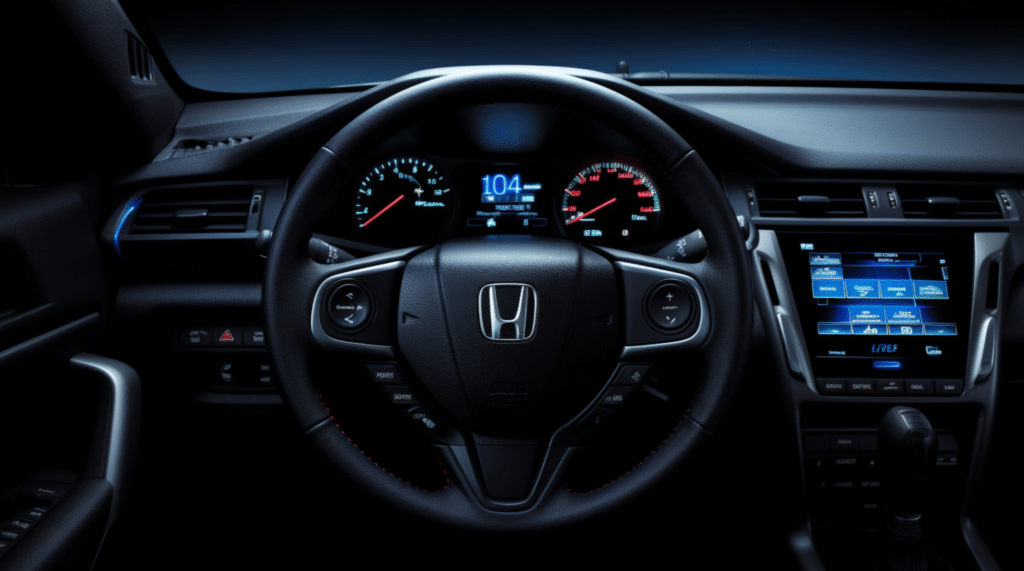Honda’s Maintenance Minder system is an important feature that takes the guesswork out of caring for your vehicle.
Unlike simple oil change lights, Maintenance Minder monitors driving conditions and alerts you to needed services based on engine load, mileage, time, and operating conditions.
This helps optimize the time between services for a lower cost of ownership.
When the wrench symbol appears, it’s time for scheduled maintenance. The letter/number codes that follow indicate what service is due.
For example, code A1 means rotating tires and replacing engine oil and filters. Without understanding what each code means, these alerts are cryptic.
In this simple guide, we’ll demystify Honda’s maintenance codes so you know exactly what service is needed when that wrench light pops on.
You’ll learn what the main service codes stand for, what additional sub-codes tell you, and easy ways to reset the Maintenance Minder once services are performed.
Understanding Honda maintenance codes helps you stay one step ahead in routine service for optimal vehicle reliability.
Understanding the Maintenance Minder Codes
Honda vehicles have a built-in Maintenance Minder system to alert drivers about recommended maintenance schedules.
Instead of following fixed intervals, the Maintenance Minder assesses vehicle operating conditions, driving style, and use, then signals through various codes on your dashboard when servicing should be performed.
When the ignition is turned and goes through its cycle test, a code may briefly display indicating which maintenance is recommended at your next service.
For example, code A1 indicates an oil and filter change, tire rotation, fluids check, and more basic tasks. Code B1 involves evaluating brakes, coolant level, accessory belts, leaks, and other key items.
The final code is 0, meaning your Honda dealership completed all necessary work and reset the Minder.
The Maintenance Minder system uses algorithms to calculate the percentage of engine oil-life remaining.
It continually monitors variables related to oil deterioration factors like high temperatures, heavy loads, engine RPMs, fuel/air ratios, miles driven, and more.
As your oil and filters age, the Minder displays a “service” symbol and a percentage of oil life remaining or vague maintenance codes.
When the displayed oil life reaches 15%, the Maintenance Minder will signal you to schedule your next service visit. Don’t wait until the oil monitor displays 0% or prompts flash urgently.
This leads to accelerated engine wear and potentially voids your powertrain warranty. By thoughtfully scheduling routine service through Minder codes, you can optimize upkeep and extend the healthy lifespan of your Honda vehicle.
Deciphering the Codes
Code 1: Tire Rotation and Inspection
Code 1 indicates it is time to rotate and inspect your tires at your next visit. By having tires rotated at 6,000-8,000 miles, they wear more evenly and extend their lifespan.
Any abnormal wear, damage, or irregular patterns should be addressed promptly for safety. Your Honda technician can determine the best next steps.
Code 2: Air Cleaner, Dust and Pollen Filter Replacement, and Drive Belt Inspection
Code 2 signals that your vehicle’s cabin air filter needs replacement and drive belts need inspection.
Replacing these filters every 1-2 years removes dust, allergens, and pollutants from entering your ventilation system.
Your technician will also check that accessory drive belts have no cracks, fraying or poor tension that could lead to failure.
Code 3: Transmission Fluid Change
Code 3 prompts you to change the automatic transmission fluid (ATF). This specialized fluid lubricates transmission components and degrades from heat and friction over time.
Draining old ATF and refilling helps avoid early wear and the potential need for a rebuild.
Code 4: Spark Plug Replacement and Valve Clearance Inspection
When code 4 appears, your spark plugs are due for a swap at your next visit. Iridium-tipped plugs normally last 105-125 thousand miles.
Deteriorated plugs waste fuel, lose power, idle roughly, and can fail. Your technician will also perform a valve clearance check during this service.
Code 5: Engine Coolant Replacement
Honda recommends replacing engine coolant fluid at five years or 60,000 miles to maintain corrosion protection within the system.
This full system flush prevents overheating issues. Letting coolant age excessively risks gasket leaks and part failure over time.
Code 6: Rear Differential Fluid Change (for AWD models)
This code applies specifically to all-wheel drive (AWD) Honda models.
It signals that the rear differential fluid needs to be drained and refilled to lubricate the extra drive components that power the rear wheels.
The fresh fluid prevents premature wear of AWD differentials’ internal gears, bearings, and couplings.
Code 7: Brake Fluid Replacement
When Code 7 appears, it advises you to replace the hydraulic brake fluid at your next service visit. Moisture accumulation from aging brake fluid leads to corrosion and reduced braking ability over time.
Flushing and filling the old fluid with fresh, clean fluid restores the brake system hydraulics for safe, reliable stopping power.
Honda Oil Life Percentages
The Maintenance Minder system determines the remaining oil life through an algorithm that constantly monitors conditions affecting the rate of deterioration.
It analyzes engine speeds, operating temperatures, climate, and mileage accumulation.
Based on these dynamic factors, the system calculates the engine oil’s current condition and effectiveness in lubricating, coating, sealing, and protecting internal components from excessive wear.
As the oil oxidizes and breaks down from heat, fuel dilution, and blow-by contaminants over time, the system displays a decreasing percentage to estimate how much usable life span remains.
When the Oil Life display reaches 15%, it’s advising you to schedule an oil and filter change soon. This preserves the oil’s protective qualities better than waiting until 5% or empty.
However, hitting 0% does not mean the oil has completely failed or protection has diminished. A reasonable buffer remains to safely drive briefly until you can change it. Still, letting oil life reach 0% consistently accelerates wear and is not recommended.
By promptly scheduling service at 15%, you optimize value from oil changes and preserve engine health.
The Importance of Regular Maintenance
While the Maintenance Minder makes car care convenient by calculating personalized intervals based on your driving habits and style, the system still relies on the driver to promptly address coded reminders before subsequent failures occur.
Adhering to scheduled maintenance dramatically reduces the odds of being stranded with an engine failure on the roadside or needing urgent repairs.
Putting off recommended services contributes to accelerated internal wear. For example, degraded fluid no longer shields metal components grinding together, leading to harmful metal shavings circulating in oil passages.
Deferred brake flushes allow corrosion buildup, compromising integrity. Worn belts begin to squeal and crack. Fouled plugs misfire, eroding combustion chambers. These incremental damages join forces over tens of thousands of miles to sabotage the bigger system.
By investing in quick, relatively inexpensive maintenance early when codes first advise, owners, save significantly over emergency failures demanding intricate repairs or full engine and transmission rebuilds.
Replacing damaged internals is costly, while most maintenance services average under $150 when promptly addressed. So, while it may be tempting to let reminders slide longer, that bit of conserved money is trivial should you later face thousands in engine work from neglected upkeep.
Respect what the Maintenance Minder advises at each stage, and you’ll safely rack up hundreds of thousands of miles.
Dealership vs. DIY Maintenance

When your Honda displays a new maintenance code, you can take it to the dealership or perform some services at home.
There are trade-offs to each approach.
Having the dealership handle all scheduled upkeep ensures work is done thoroughly by specialized technicians according to strict factory specifications.
They have advanced tools, software updates, component scan capabilities, and advanced training on your model.
However, dealer labor rates are expensive, ranging from $125 to $150 per hour. Simple tasks get marked up significantly.
Doing basic services like oil changes, tire rotations, filter swaps, and fluid flushes yourself saves money on labor.
With a little time investment in researching proper procedures and prepping your home garage with jack stands, quality fluids, and the right tools, you can likely perform Code 1 and 2 level tasks reliably.
Attempting more complex tasks risks safety issues or catastrophic mistakes if something goes wrong.
Carefully weigh the costs of messing up against the convenience and certainty of professional dealership work.
While you may save $100 initially, a single misstep, like underfilling transmission fluid, could cause permanent damage.
Most find the long-term peace of mind of using Honda factory-approved techs and parts worthwhile. But with care and dedication, select maintenance coding levels can become DIY affairs.
Resetting Maintenance Codes
Once your Honda dealership or technician finishes performing maintenance and repairs prompted by a Maintenance Minder code, they will reset the system so it can begin tracking everything anew. Here is the process:
- Turn the ignition to “On” without starting the engine.
- Press and hold the odometer trip reset button until the multi-information display cycles to the engine oil life screen.
- Continue holding the button with the display showing 100% engine oil life.
- With the system in reset mode, press and hold the button yet again for about 10 seconds until the display shows “0%” oil life.
- Turn the ignition to lock/off.
- Start the engine and let it idle for at least 30 seconds.
- Turn it off and back on once more. The maintenance code will now be cleared and reset to base parameters.
Following the next routine service, the process repeats to reset the percentage and start tracking oil life and vehicle conditions from scratch. This allows the Maintenance Minder system to be extended in usefulness over the vehicle’s lifespan.
Case Studies: B13 and B123 Service Codes
Among all codes the Maintenance Minder uses to indicate servicing needs, special cases occur involving B warning level codes.
B13 specifically signals a major comprehensive inspection with various tests to evaluate whether multiple key vehicle systems operate within acceptable tolerances after extended use. Technicians extensively inspect for proper engine performance, transmission functionality, hybrid battery capacity, accessory belt condition, potential fluid leaks, and unusual tire wear indications and conduct an alignment check, ball joint test, suspension inspection, and AC system test. After several years, this complete analysis ensures everything continues to function reliably and safely.
Building upon B13, the expanded B123 test run by Honda thoroughly examines the same critical components and functions while adding checks for the proper operation of brakes, including caliper function, hoses, and parking brake apparatus. The charging system, accessory drive belts, Damper Pulley, steering and suspension also face additional targeted scrutiny in this exhaustive B123 assessment.
Resetting B13 and B123 requires the same process of holding down the odometer trip button through several cycles down to 0%, much like the standard oil change and tire rotation reset. However, the comprehensive scale of these assessments means significantly extended dealership service times as technicians validate the longer list of critical monitoring and performance to keep your Honda in excellent running order. But passing could grant you hundreds of thousands more future miles.
Final Thoughts
As we’ve covered, Honda’s Maintenance Minder system uses letter and number codes to indicate when specific maintenance tasks are due on your vehicle. Properly understanding and following these codes is crucial for getting the maximum longevity and performance out of your Honda.
By paying attention to service messages and adhering to the maintenance schedule, you can avoid many major repairs down the road. While the codes may seem confusing at first, consistent oil changes, fluid flushes, tire rotations, and component replacements as advised will add hundreds of thousands of miles to your Honda’s odometer.
Keep this guide handy and refer back to it whenever a maintenance code pops up. Following through on the indicated tasks on schedule will ensure your Honda continues running smoothly for years to come. Consistent care brings consistent reliability.

